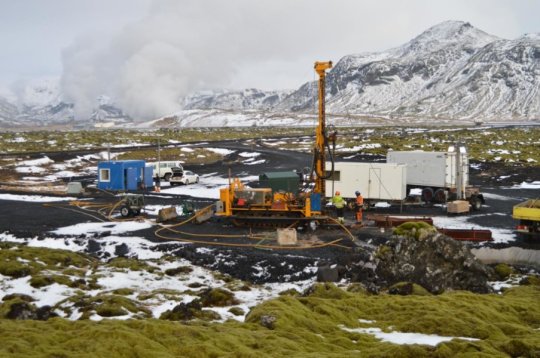An international team of scientists have found a potentially viable way to remove anthropogenic (caused or influenced by humans) carbon dioxide emissions from the atmosphere — turn it into rock.
The study, published in Science, has shown for the first time that the greenhouse gas carbon dioxide (CO2) can be permanently and rapidly locked away from the atmosphere, by injecting it into volcanic bedrock. The CO2 reacts with the surrounding rock, forming environmentally benign minerals.
Measures to tackle the problem of increasing greenhouse gas emissions and resultant climate change are numerous. One approach is Carbon Capture and Storage (CCS), where CO2 is physically removed from the atmosphere and trapped underground. Geoengineers have long explored the possibility of sealing CO2 gas in voids underground, such as in abandoned oil and gas reservoirs, but these are susceptible to leakage. So attention has now turned to the mineralisation of carbon to permanently dispose of CO2.
Until now it was thought that this process would take several hundreds to thousands of years and is therefore not a practical option. But the current study — led by Columbia University, University of Iceland, University of Toulouse and Reykjavik Energy — has demonstrated that it can take as little as two years.
Lead author Dr Juerg Matter, Associate Professor in Geoengineering at the University of Southampton, says: “Our results show that between 95 and 98 per cent of the injected CO2 was mineralised over the period of less than two years, which is amazingly fast.”
The gas was injected into a deep well at the study site in Iceland. As a volcanic island, Iceland is made up of 90 per cent basalt, a rock rich in elements such as calcium, magnesium and iron that are required for carbon mineralisation. The CO2 is dissolved in water and carried down the well. On contact with the target storage rocks, at 400-800 metres under the ground, the solution quickly reacts with the surrounding basaltic rock, forming carbonate minerals.
“Carbonate minerals do not leak out of the ground, thus our newly developed method results in permanent and environmentally friendly storage of CO2 emissions,” says Dr Matter, who is also a member of the University’s Southampton Marine and Maritime Institute and Adjunct Senior Scientist at Lamont-Doherty Earth Observatory Columbia University. “On the other hand, basalt is one of the most common rock type on Earth, potentially providing one of the largest CO2 storage capacity.”
For more visit ScienceDaily website.
Photo: CarbFix I pilot CO2 injection site during wireline diamond drilling to recover a 150 m of core from the CO2 storage reservoir in 2014 (~2 years after CO2 injection). Steam emissions from the Hellisheidi geothermal powerplant are visible in the background.










